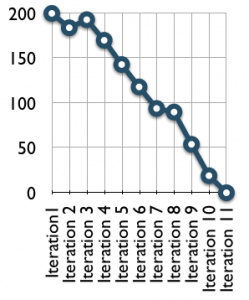Pyxis created the PATH model to facilitate the diagnosis of the Agile maturity level within a team in order to recommend the appropriate intervention. PATH is:
- An intervention approach within the organization;
- A model allowing to lessen the impact of an Agile transition.
PATH is an acronym for Process-Added value-Technologies-Human, the 4 dimensions of software development.
Processes: Efficiently deliver value with a simple process adapted to the project’s needs (lowest cost within time).
Added value: Deliver functionalities and maximize their business value (prioritization and flexibility).
Technologies: Deliver quickly and consistently with appropriate engineering practices (sustainable pace and skills development).
Human: Deliver at a sustainable pace and in harmony while promoting team work (collaboration and communication).
In addition to the dimensions, the PATH model introduces 3 influence levels—vision, funnelling and emergence—that, when applied to all 4 dimensions, produces 12 intervention areas.
Vision
The ‘Vision’ level shows the orientation to meet established objectives. This level is generally linked to the strategic vision of the organization. The vision represents the objectives to achieve.
For instance:
Maximization of return on investment:
- Connection between the IT group and business units, and globally between all stakeholders
- Development of inter-project synergies in order to adopt best practices and pool them
- Management of simple and adaptable projects in order to reduce administration fees
- Capacity to innovate in order to be equipped with the tools required for the organization to evolve
- Capacity to anticipate in order to gain a competitive edge
- Greater respect for budget allowance
Maximization of a cooperation and collaboration culture:
- Better team organization
- Evolution of the strategy and change culture
- Adaptation of the leadership model
Performance:
- Quick project execution compared to traditional approaches
- Quality improvement of software delivered
- Establishment of parameters allowing to measure performance
- Adaption of the competency model and expertise development
- Process implementation to select initiatives
Funnelling
The main objective of the ‘Funnelling’ level is to implement mechanisms promoting collaboration (e.g. communities of practice, wikis, and blogs).
This level:
- Allows to implement a communication approach in order to make the vision visible
- Allows to make sure the field practices (emergence) are aligned with the objectives established at the ‘Vision’ level
Therefore, funnelling allows the emergence of the best practices arising from development teams as well as the dissemination of these practices to all groups that may benefit from them. Therefore, the ‘Funnelling’ level acts as an information catalyst and aggregate.
Globally, the objective of this level is to ensure reuse of:
- Tools
- Practices
- Experience acquired by stakeholders
Emergence
The ‘Emergence’ level is the level for project teams developing software solutions. It is important to implement new development processes and train team members on how to apply Agile principles.
At this level, transformations imply:
- New ways of doing
- A behaviour oriented towards collaboration in order to achieve established objectives
- The implementation of methods allowing to obtain best results

 The content of the template is updated at the end of each Sprint. Below, the SunSet graph after 6 sprints.
The content of the template is updated at the end of each Sprint. Below, the SunSet graph after 6 sprints.
Recent Comments